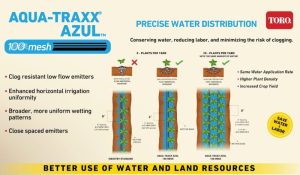
Toro Ag’s Advanced Drip Irrigation Systems
https://irrigationleadermagazine.com/volume-15-issue-3-mar/

https://irrigationleadermagazine.com/volume-15-issue-3-mar/
Micro-sprinklers have long been used to provide climate control and irrigate fruit, nut and cover crops. Now, micro-sprinklers can be used as part of an integrated pest management (IPM) plan in row crops, as well.
Click here to download Toro’s official guide to Subsurface Drip Irrigation (SDI). For Spanish, click here.
Subsurface Drip Irrigation is a specialized sub-set of drip irrigation where dripline or drip tape “lateral lines” (tubes buried beneath the crop rows) and supply and flushing “submains” (pipes supplying water to the lateral lines) are buried beneath the soil surface for multi-year use. The technique of burying less expensive Bi-Wall drip tape laterals beneath field crops was pioneered in the American Southwest decades ago, and has since been implemented by researchers and growers alike. The SDI technique is now being used throughout the world on a wide range of grain forage and fiber crops including alfalfa, corn, cotton, soybeans and sugarcane. In addition to drip tape, thinwall integral driplines are commonly used as well.
Choosing the right drip tape emitter spacing can be more of an art than a science. This is because of the many variables that exist in each farming application, including tape placement, soil type, crop, plant population, soil and water salinity, tape quality and cost, etc. Fortunately, Cal Poly San Luis Obispo’s recent Drip and Micro Irrigation Design and Management Manual, published by the Irrigation Training and Research Center (ITRC) in 2007, provides a great deal of guidance for this important decision. In particular, the new manual discusses how closely spaced drip tape emitters can enhance salt management for seed germination, leach salts in permanent crops, and dilute soil salinity for salt sensitive crops. In addition, the manual highlights some of the agronomic and economic disadvantages of using widely spaced emitters.
Watch the following Drip Irrigation Installation video to find out how Midwest growers are using subsurface drip irrigation to grow better crops with fewer inputs. The investment often pays for itself in less than two years.
Drip Irrigation scheduling is the process of deciding when to run the drip irrigation system, and for how long. It is a complex topic but of utmost importance because it influences whether the crop gets the right amount of water and nutrients, and whether valuable water is wasted to runoff or deep percolation. Irrigation scheduling combines data and agronomic expertise in that the irrigator must balance known facts such as weather, chemistry, stage of plant growth and farm cultural operations.
To help farmers, dealers, and manufacturers recognize and understand some of the problems that have been experienced with drip tape (problems that are quite different from manufacturing defects), the Irrigation Training and Research Center (ITRC) published a drip tape problem guide called “Diagnosing and Avoiding Damage to Drip Tape.” Problems that are quickly detected and properly identified can often be remedied, or be avoided in the future.
The Drip Irrigation Owner’s Manual was developed by Toro to be a comprehensive drip irrigation guide for both new and existing row, field, and permanent crop growers. The manual helps growers take full advantage of the precise, efficient, and practical benefits of a drip irrigation system. Topics include drip irrigation system overview, starting-up your drip irrigation system, basic system operation, fertigation, chemigation, salinity management, system maintenance, and maximizing your investment. The Drip Irrigation Owner’s Manual heavily references both government and academic sources, is beautifully illustrated, and is simply written in lay terms.